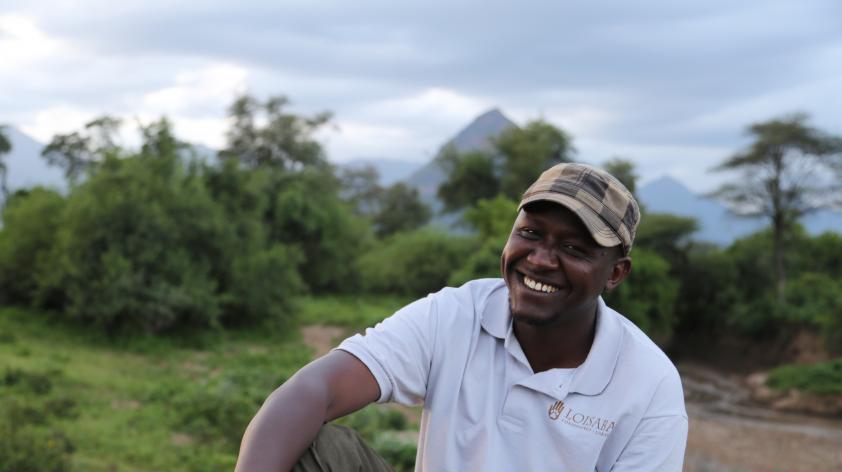
Symon Says: Let’s Save Wildlife
I was born and raised by pastoralist parents and knew very little about education. They kept shoats (a herd of sheep and goats) and cattle—my mother looked after the shoats and my father after the cattle. After I was born, my father decided to marry a second wife so that she can take care of the shoats while my mother stayed at home with the baby (me).
When I grew up, I started learning to look after the shoats, as all other pastoralist children do. At eight years old, I was taken to nursery school and within the same year I joined class one. I grew up seeing many different kinds of wildlife in our home area (Il-polei). There were many zebras, impalas, giraffes, elands, oryx, Thomson’s and grant gazelles, dik diks, warthogs, and countless different birds species. The only species that just started coming recently was the elephant, and they would not stay long. When I was young, the droughts were not as severe as they are now, and the number of people and livestock were not as many as you see now.
I have always loved nature. When I was a young boy, I received a lot of beatings from my parents because of losing shoats to predators, likely because I was looking at the locusts, grasshoppers, butterflies, or the ants. In high school I joined wildlife and environmental clubs and that’s where my conservations interest grew. My prayer was to work in conserving the environment and the natural resources.
Over the last three decades I have seen the number of wildlife decrease and the numbers of people and livestock increase exponentially. The group ranches have become very small and many people have to move to other places to look for pieces of land to buy for their livestock. The group ranches had exceeded carrying capacity for both livestock and people, the wildlife have been pushed to ranches and poached for meat and other parts.
For the last 17 years, I have been involved in different projects with various organizations working to conserve wildlife and the habitat they need. Currently, I work as a reticulated giraffe project coordinator and chief research officer for San Diego Zoo Global in northern Kenya. In December 2016, the International Union for Conservation of Nature (IUCN) moved the giraffe two categories down the IUCN Red List of Threatened Species from "Least Concern" to "Vulnerable." This was due to the giraffe's dramatic 40 percent decline in the last three decades.
Now we face a race against time to preserve our giraffe species before it’s too late.
The giraffe initiative will help us better understand the threats to giraffes by learning about pastoralists’ interactions with them, and discovering the impact that livestock has on the behaviors of giraffes. The program will be identifying individual giraffes through photos, and collect monitoring data using GPS units and a network of camera traps.
Giraffes are facing the following challenges and need to be looked into or addressed:
Giraffes are hunted for their hides and meat. Giraffe tails are highly used by many African cultures. The desire for good luck bracelets, fly whisks, and threads for sewing or stringing beads have led people to kill the giraffe for their tail. Giraffes are also poached for meat. In March 2017, the scouts of Loisaba Conservancy Laikipia-Kenya found a carcass of a snared giraffe, and we discovered that three-quarters of the giraffe had already been eaten.
Giraffes are quickly losing their living spaces. The number of giraffes in the wild is shrinking as their habitats shrink. Human/livestock populations are increasing, along with agricultural activities, expanding settlements, and building roads, all impact the giraffe’s beloved acacia and other shrubs, which are the sources of their food. In October 2016, as I was driving to Namunyak through the Isiolo Marsabit highway, I found a giraffe that had been knocked down by a speeding Toyota Hilux. The worse thing was that the giraffe was in labor, about to give birth, and though the mother was dead, the calf was still pushing to come out.
In general, land loss, habitat fragmentation, human over-population, unsustainable agriculture, the illegal poaching for hide, fur, meat, and tails will be the most critical destructive factors that could push giraffes into extinction within the next decade or two
With numbers of threatened species at its highest, the natural world needs our help. The thought of being able to help animals is a dream of mine. I want to educate people about how we can tackle the threats that animals are faced with. My ultimate goal is to have a lifelong career dedicated to conservation. This route will provide opportunities to combine my curiosities from biology and conservation into one. I am aware of the challenges the world faces between humans and wildlife, and without conservation, ecosystems can fall apart causing the loss of both.
By Symon Masiaine, Reticulated Giraffe project Co-ordinator and Chief Researcher













